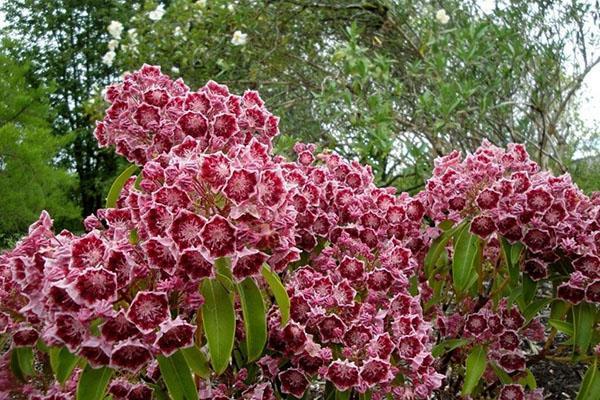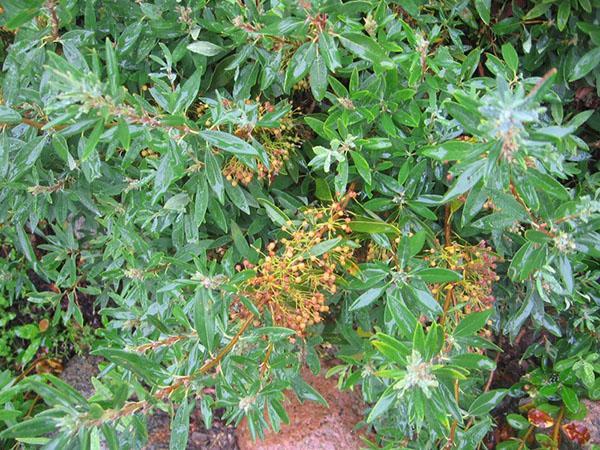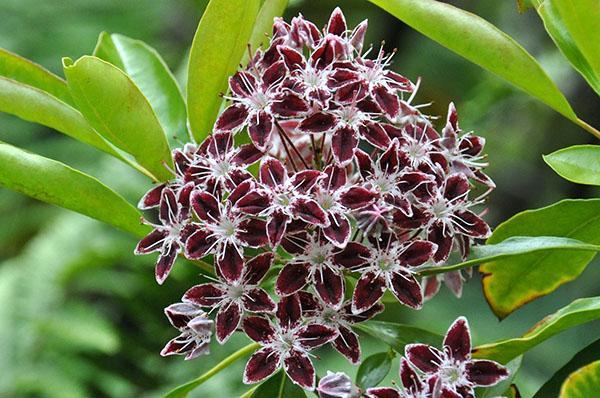Charming garden beauty kalmia: planting, care and photo
 When it is time for plants to bloom, the garden becomes a unique place of delight. Especially if a perennial shrub grows in it - kalmia. The plant belongs to the Heather family. It was first discovered in North America. There, the shrub is found in swampy areas, forest edges or dense thickets.
When it is time for plants to bloom, the garden becomes a unique place of delight. Especially if a perennial shrub grows in it - kalmia. The plant belongs to the Heather family. It was first discovered in North America. There, the shrub is found in swampy areas, forest edges or dense thickets.
Under natural conditions, kalmia grows up to one and a half meters, although there are also undersized species - about 30 cm. The shrub got its name in honor of the Finnish environmental researcher Pierre Kalm.
Nowadays, kalmia adorns gardens not only in America, but throughout Europe. Thanks to the diligence and painstaking work of botanists, the plant appeared in the Moscow region.
General information about the shrub

With the onset of summer season, delicate cupped flowers appear on numerous stems. They are:
- red;
- pink;
- white;
- cream;
- burgundy;
- patterned.
 Interestingly, the buds are collected in small umbrella-shaped bouquets. Each of them reaches up to 1 cm in diameter. When the shrub blooms, a huge number of such delicate inflorescences appear on it. In this photo, kalmia amazes with its charm and beauty.
Interestingly, the buds are collected in small umbrella-shaped bouquets. Each of them reaches up to 1 cm in diameter. When the shrub blooms, a huge number of such delicate inflorescences appear on it. In this photo, kalmia amazes with its charm and beauty.
There are many different varieties of overseas shrubs that grow well in Russia. Many of them are quite winter-hardy, therefore they are used in summer cottages and in the Moscow region. One of these varieties is broadleaf Calmia.
Description of the famous species
 This type of kalmia is a broadly spreading plant, reaching a height of about 3 meters.
This type of kalmia is a broadly spreading plant, reaching a height of about 3 meters.
In their natural environment, there are kalmia trees that grow up to 12 m in height. Moreover, they differ in a wide and branched crown. In summer cottages, shrubs are most often used.
The height of broadleaf calmia in the Moscow region reaches an average of about 80 cm.Over a year it grows by 2 cm.
The leaves of the plant are elliptical, lanceolate. Outwardly, they resemble the leaves of a laurel tree. Their length, on average, ranges from 10 cm to 50. The upper plate is colored dark green, the lower part with a yellowish tint.
Particularly prominent are the saucer-shaped flowers, collected in umbrella inflorescences. The color of delicate buds is most often pink. Inside each flower are dark anthers, which are involved in the reproduction of the plant. During the flowering period of the shrub, the buds cover almost the entire crown of the calmia.
If you look closely at the individual flowers, they look like miniature porcelain cups.
 The diameter of such a work of art is only 2.5 cm. The plant begins to bloom in the last month of spring or early summer. After that, the fruits appear on the kalmias in the form of graceful capsules, densely filled with seeds. They are fully ripe by mid-autumn.
The diameter of such a work of art is only 2.5 cm. The plant begins to bloom in the last month of spring or early summer. After that, the fruits appear on the kalmias in the form of graceful capsules, densely filled with seeds. They are fully ripe by mid-autumn.
As biological studies show, flower buds form a full year before flowering. Therefore, one should not worry in vain if the young plant did not bloom immediately after planting.
There are some peculiarities of planting and caring for Kalmy broadleaf.
If you want to quickly plant a shrub on your personal plot, it is advisable to plant it in the spring. To do this, you can purchase seedlings that have been grown in pots.
Plants should have leaves that are dark green in color, which indicates its vitality. If they are located only at the tips of the shoots, it means that the kalmia has a damaged or felted root system.
The most suitable place for a shrub is a semi-shaded area in the country. It can be planted next to a tall tree, which will provide the plant with ideal growth conditions.
 Acidic soil with good water permeability is suitable for planting Calmia broadleaf. It can be sandy soil fertilized with humus.
Acidic soil with good water permeability is suitable for planting Calmia broadleaf. It can be sandy soil fertilized with humus.
Immediately before planting the seedling in the hole, it is advisable to put peat. This will give the plant enough minerals to grow.
Due to the fact that the root system of kalmia is close to the soil surface, it is not necessary to plant other plants nearby. They can drown it out, which will lead to illness or complete drying.
When caring for a bush, you should adhere to these rules.:
- Top dressing. Three times per season, the soil around the plant must be fed. In the spring, you can use the solution urea (30 grams per 8 liters of liquid). In the autumn, mineral fertilizers are scattered under the bushes. When the plant is actively developing, the root system can be fertilized with slurry. For this, one part of the manure is diluted with 15 parts of water. Then, the bushes are watered with this solution.
- Watering. In order for the shrub to develop well, it must be provided with competent watering. It consists in a moderate distribution of moisture under the bush. It is important that the soil dries out a little before the next watering. When preparing a shrub for wintering, it should be poured abundantly with water and mulched with tree bark and peat.
- Regular branch care. As soon as spring comes, kalmia bushes should be cleaned of dry branches and inflorescences. There is no need to prune the plant, as it always has a beautiful crown.
- Loosening the soil. As a result of abundant spring rainfall, the soil under the bush hardens. Therefore, you should carefully fluff the soil. Thanks to this, the roots receive oxygen, and the plant develops well.
In addition to broadleaf calmia, there are other types of shrubs. Let's consider some of them.
Popular types of charming bush
The genus of evergreen calmia has about 8 species that are widely known in America and Europe. Of these, only a few have taken root well in Russia. For many summer residents in the suburbs, kalmia has become a favorite garden decoration.
Narrow-leaved Kalmia
 This type of shrub grows up to 1.5 m in height. Also known are dwarf varieties that grow up to 40 cm.
This type of shrub grows up to 1.5 m in height. Also known are dwarf varieties that grow up to 40 cm.
The leaves of the plant are lanceolate, oblong, about 6 cm long.The upper part is colored green, and the lower one has a bluish tint.
Narrow-leaved Kalmia has amazing inflorescences in the form of a cup. They are almost always pink, and only rarely white. The buds are collected in umbrella-shaped inflorescences. Each bud is approximately 1 cm in diameter. In general, the flowers look chic, especially when they bloom at the same time. Therefore, we can safely say that kalmia is a real natural masterpiece at their summer cottage.
An ornamental narrow-leaved shrub variety has been bred since 1736 outside of Russia. Only a century later, the evergreen shrub was brought to Moscow. Since 1988 the plant has been growing in the Botanical Garden. There it blooms annually and pleases the eye for a whole month.
Multifoliate Kalmia
 This evergreen variety has a compact, raised crown. The original lanceolate leaves of Calmia multifoliate are colored dark blue-green.
This evergreen variety has a compact, raised crown. The original lanceolate leaves of Calmia multifoliate are colored dark blue-green.
The buds appear on the shoots in late April or early May. In shape, they resemble miniature bells, which are collected in delightful bouquets. The flowers are painted pink, which looks original against the background of green leaves.
Planting a perennial
 Competent planting of kalmia and caring for the plant requires the fulfillment of such requirements:
Competent planting of kalmia and caring for the plant requires the fulfillment of such requirements:
- plant only in loose, drained soil;
- prevent liquid stagnation;
- during drought, water once every 2 weeks with plenty of water (up to 10 liters per bush);
- if necessary, watering in the morning or in the evening;
- timely fertilization contributes to the rapid growth of the shrub.
Reproduction
These types of kalmia reproduce in two ways: with the help of seeds and by separating the roots from the main plant. When choosing the appropriate option, you should consider your capabilities.
 One of the simplest methods for breeding kalmia is to use root shoots. For this, the offspring are planted in containers, where they develop for 3 years. When the plant turns into a full-fledged seedling, it is transferred to the garden plot. There he takes his honorable permanent place, where he will serve as a decoration of the front garden for many years.
One of the simplest methods for breeding kalmia is to use root shoots. For this, the offspring are planted in containers, where they develop for 3 years. When the plant turns into a full-fledged seedling, it is transferred to the garden plot. There he takes his honorable permanent place, where he will serve as a decoration of the front garden for many years.
To grow calcium from seeds, you need to collect planting material on time. The most suitable period is mid-autumn. After collecting the seeds, they must be dried and stored in a dry place.
For better germination, the seeds are kept in the cold for about 2.5 months, and only then are they sown.
Calmia sown in special containers will sprout after 30 days. They grow very slowly at first, but with patience, we will receive a reward. When they grow up to 4 cm, the seedlings can be dived if necessary.
After 2 years, the seedlings begin to feed mineral fertilizers... Thanks to this, they will begin to grow faster. When young kalmias begin to branch, it is better to transplant them into new containers, where they will be up to 5 years of age. Then the seedlings are planted in a permanent place in the garden. And then they will become the gentle charm of a summer cottage in the Moscow region.